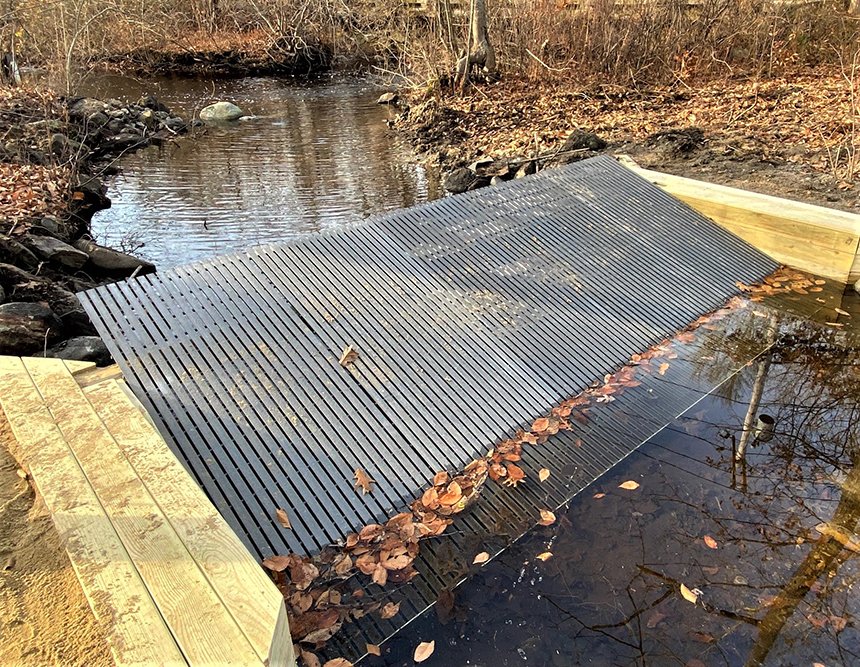Wrong Turn on Gilbert Stuart Brook Closed to River Herring
By ecoRI News staff

The project is designed to keep thousands of fish from becoming stranded in the mill race, strengthening one of Rhode Island most important spring runs of river herring. (Tim Mooney/TNC)
Last month The Nature Conservancy (TNC) and the Rhode Island
Department of Environmental Management (DEM) built a small wood and fiberglass
structure at a fork in the Gilbert Stuart Brook, closing off a costly detour
for migrating river herring.
The structure, known as a picket weir, consists of five removeable
grates, resting on wooden abutments and set in the water at a 30-degree angle.
Durable and easy to maintain, the structure will be stored offsite each year
from June to February and then reinstalled in March, just prior to the start of
the herring run.
The goal of the project is to prevent river herring from swimming
into a historic mill race canal that dates to the mid-1700s. Whenever water
flows over the Gilbert Stuart dam in the spring — because of heavy rain or the
operation of the waterwheel — it creates false attraction to the mill race,
which leads to a dead end at the base of the Gilbert Stuart dam. As the water
levels recede, the fish become stranded and perish, if not rescued by DEM staff
and volunteers.
The picket weir replaces DEM’s longstanding practice of using
temporary plastic fencing to deter herring from the mill race. While
inexpensive, the fencing trapped debris flowing downstream and was prone to
failing during high flows.
The new approach was developed by Bryan Sojkowski, a regional fish
passage engineer with the U.S. Fish & Wildlife Service (USFWS), which
assisted DEM through a partnership with TNC. Sojkowski noted the situation at
Gilbert Stuart Museum is not unique, and if the design is successful, it could
be applied on other streams in Rhode Island.
“As a fish passage engineer, I’m typically designing fishways to move fish upstream or downstream, over a barrier,” Sojkowski said. “In this case, it was the reverse. We needed to block fish from moving upstream.”
Up to 250,000 adult river herring return annually from the
Atlantic Ocean and swim up the Narrow River into Gilbert Stuart Brook. The
picket weir is designed to keep herring in the main channel, where they can
pass through a fish ladder behind the museum to reach Carr Pond to spawn.
(Tim Mooney/TNC)
The work at Gilbert Stuart Museum is the latest in a series of
fish passage improvement projects in South County. The TNC-DEM-USFWS project
team previously corrected deficiencies at fish ladders on the Saugatucket and
Annaquatucket rivers that were preventing river herring from migrating
upstream.
River herring are important to the ecosystem, providing forage for
ospreys, bluefish, striped bass, and many other animals.
The picket weir construction contract was awarded to SumCo Eco-Contracting of Peabody, Mass., through a competitive bidding process. The project was funded by grants from the Horace & Ella Kimball Foundation and the Narragansett Preservation and Improvement Foundation.
The Gilbert Stuart
Birthplace & Museum was a key partner and provided logistical support as
the landowner. Total construction cost was $54,000.